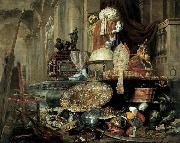Wholesale Oil Painting No Minimum |
|||||||||||
|
|
|||||||||||

|
|||||||||||
|
|
|
||||||||
Pieter Boel(1626-1674) was a Flemish Baroque painter who specialised in lavish still lifes. Boel was born in Antwerp. He probably went to Italy in 1650. In 1668, he worked for Charles Le Brun (1619-1690) in his first tapestry making studio. According to Arnold Houbraken, whose source was his picture in Cornelis de Bie's book Het Gulden Cabinet, he specialized in painting animals. He died in Paris. |
||||||||
|
|
||||||||
Allegorie der Verganglichkeit der Welt
Allegorie der Verganglichkeit der Welt Painting ID:: 74552 |
1663
Oil on canvas
207 X 260 cm
cjr 1663 Oil on canvas 207 X 260 cm cjr |
|||||||
|
|
||||||||
|
BOEL, Pieter Flemish Baroque Era Painter, 1622-1674 Flemish painter, draughtsman and etcher. He came from an artistic family: his father Jan Boel (1592-1640), was an engraver, publisher and art dealer; his uncle Quirin Boel I was an engraver; and his brother Quirin Boel II (1620-40) was also a printmaker. Pieter was probably apprenticed in Antwerp to Jan Fyt, but may have studied previously with Frans Snyders. He then went to Italy, probably visiting Rome and Genoa, where he is supposed to have stayed with Cornelis de Wael. None of Boel's work from this period is known. In 1650 he became a master in the Antwerp Guild of St Luke (having given his first name as Jan, not Pieter). His marriage to Maria Blanckaert took place at about the same time. Boel dated only a few of his paintings, making it difficult to establish a chronology. He is best known for his hunting scenes, some of which clearly show his debt to Snyders, but the dominant influence on his work was that of Fyt, particularly evident in his emphatic brushwork. However, Boel was more restrained both in his treatment and in his handling of outline. He also borrowed the theme of open-air hunting still-lifes (e.g. Feathered Game with Three Dogs; Madrid, Prado) from Fyt, but he painted other subjects as well, such as the monumental Vanitas Still-life (e.g. 1633; Lille, Mus. B.-A.). Allegorie der Verganglichkeit der Welt Date 1663 Medium Oil on canvas Dimensions 207 ?? 260 cm cyf |
||||||||
|
|
||||||||
|
Prev Next
|
||||||||
|
|
||||||||
|
Related Paintings to BOEL, Pieter :. |
||||||||
|
|
||||||||
|
CONTACT US |

